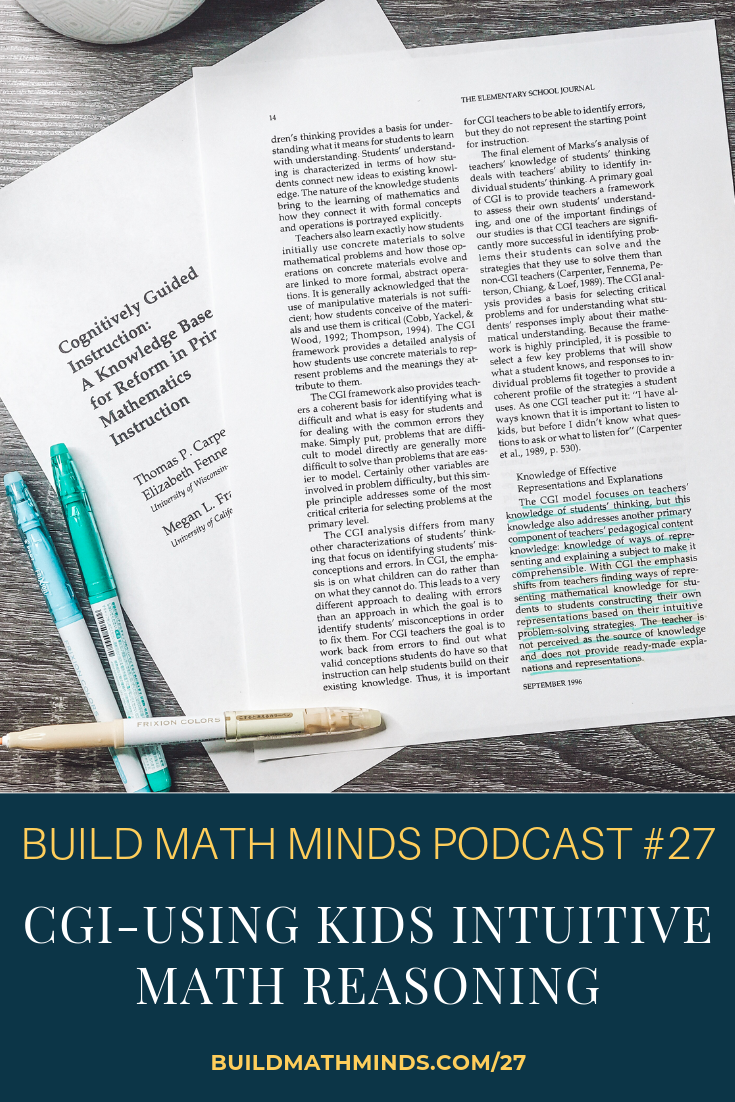Resources mentioned in this episode:
Cognitively Guided Instruction: A Knowledge Base for Reform in Primary Mathematics Instruction article by Carpenter, Fennema, and Franke.
Build Math Minds Podcast Episode 1: Cognitively Guided Instruction
Download Your Guide To Teaching Elementary Mathematics Without a Textbook
Welcome fellow Recovering Traditionalists to Episode 27. Today we are looking at Using Kids Intuitive Mathematical Reasoning
If you follow my blog, The Recovering Traditionalist, then you know that I’m doing a series of videos to kick off the school year all about how and why to teach math without a textbook.
One of the biggest influences on my belief about teaching math without a textbook is the research of Cognitively Guided Instruction. One of the very first episodes of this podcast was about the book Children’s Mathematics: Cognitively Guided Instruction.
For this episode I want to direct you to a research article by some of the same authors. As I was reading through some of their research I came across the passage I’m going to read and thought it fits so great with this theme of teaching without a textbook. One of the reasons I don’t like textbooks is that it’s a one-size-fits-all approach to teaching students. Students come to you with different backgrounds, different mathematical knowledge, etc and it is so imperative that you use that because if you don’t, you are teaching a textbook, you are not teaching students.
Today’s insight comes from pages 14 and 15 of Cognitively Guided Instruction: A Knowledge Base for Reform in Primary Mathematics Instruction
“The CGI model focuses on teachers’ knowledge of students’ thinking, but this knowledge also addresses another primary component of teachers’ pedagogical content knowledge: knowledge of ways of representing and explaining a subject to make it comprehensible. With CGI the emphasis shifts from teachers finding ways of representing mathematical knowledge for students to students constructing their own representations based on their intuitive problem-solving strategies. The teacher is not perceived as the source of knowledge and does not provide ready-made explanations and representations.
This distinction can be seen in the difference between the way that multiplication and division are portrayed in CGI and in many traditional textbooks and methods texts, which often employ arrays as the primary representation for multiplication and division. Arrays have an advantage over the grouping strategies that students typically invent to represent multiplication and division problems in that they illustrate the commutative property of multiplication. However, students do not naturally use arrays as representations for problem situations that do not specifically describe arrays. Students’ initial representations may not be the most efficient or provide the clearest insights about important mathematical concepts, but our goal is not to provide teachers with representations to teach directly to students. Rather, it is to help the teachers understand the ways students intuitively solve problems, so that they can help students build on that knowledge.”
They continue to say:
“The curriculum in most CGI classes is derived from analyzing the development of students’ mathematical thinking (Fennema et al., in press). Students spend most of their time solving problems and discussing alternative solutions. Using the classification of problem types as a guide, teachers make up many of the problems based on activities in which the class is engaged. Sometimes problems come out of activities in other subjects such as science or social studies, or are made up from contexts in story books. Sometimes the problems arise naturally in daily class activities like figuring out the lunch count or sharing treats.”
So, in a nutshell, CGI is about using contextual problems that are based on things your students are interested in or are happening in your school. Then you let the kids solve the problems using their intuitive strategies. You do not tell them how to solve it. Once they have solved the problem then you move to having discussions about how the children solved the problem and comparing & contrasting their strategies. Through this students will see other students who solved it a bit more efficiently and grab onto that strategy. They naturally progress to more fluency. You don’t have to directly teach them the strategies using your textbook, they learn them from each other.
So, are you teaching a textbook or are you using your students’ thinking and understandings to drive your instruction. Or are you somewhere in between?
If you are wanting to use your students’ intuitive math knowledge and strategies then I want to encourage you to download my free guide that will help you get started. Go to buildmathminds.com/notextbook to get Your Guide to Teaching Elementary Math Without a Textbook.
It will help you go through the steps of how to change your teaching to not rely upon the textbook and use your students’ knowledge to help guide your instruction.
Subscribe and Review in iTunes
Hey, are you subscribed to the Build Math Minds Podcast, yet? If you’re not, make sure to do that today because I don’t want you to miss any episodes! Click here to subscribe to the podcast in iTunes.
While you’re there, don’t forget to leave a review on iTunes too. I would love to know your thoughts and how we can make sure that we give you content that you will really enjoy.
To leave a review, head over to iTunes and click on “Ratings and Reviews” and “Write a Review.” I can’t wait to hear your thoughts about the podcast.




